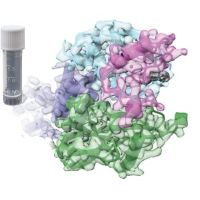Specification
| Description | Recombinant protein from the full-length sequence of Homo sapiens ring finger and CCCH-type domains 1 (RC3H1), transcript variant 2 (NM_172071). |
| Organism | Homo sapiens (Human) |
| Expression Host | Human Cells |
| Tag Info | His or DYKDDDDK. Please contact us if you need further information or require specific designed tag. |
| Purity | Greater than 90% by SDS-PAGE gel |
| Uniprot ID | Q5TC82 |
| Entry Name | RC3H1_HUMAN |
| Gene Names | RC3H1 KIAA2025 RNF198 |
| Alternative Gene Names | KIAA2025 RNF198 |
| Alternative Protein Names | Roquin-1 (Roquin) (EC 2.3.2.27) (RING finger and C3H zinc finger protein 1) (RING finger and CCCH-type zinc finger domain-containing protein 1) (RING finger protein 198) |
| Application | Antigens, Western, ELISA and other in vitro binding or in vivo functional assays, and protein-protein interaction studies; For research & development use only! |
| Buffer | Purified protein formulated in a sterile solution of PBS buffer, pH7.2, without any preservatives |
| Endotoxin | Endotoxin level is < 0.1 ng/µg of protein (<1EU /µg) |
| Length | 1133 |
| Molecular Weight(Da) | 125736 |
| Protein Sequence | (The sequence of expressed protein may have some variation from the sequence shown below. Please contact us for the exact sequence.) MPVQAPQWTDFLSCPICTQTFDETIRKPISLGCGHTVCKMCLNKLHRKACPFDQTTINTDIELLPVNSALLQLVGAQVPEQQPITLCSGVEDTKHYEEAKKCVEELALYLKPLSSARGVGLNSTTQSVLSRPMQRKLVTLVHCQLVEEEGRIRAMRAARSLGERTVTELILQHQNPQQLSSNLWAAVRARGCQFLGPAMQEEALKLVLLALEDGSALSRKVLVLFVVQRLEPRFPQASKTSIGHVVQLLYRASCFKVTKRDEDSSLMQLKEEFRTYEALRREHDSQIVQIAMEAGLRIAPDQWSSLLYGDQSHKSHMQSIIDKLQTPASFAQSVQELTIALQRTGDPANLNRLRPHLELLANIDPSPDAPPPTWEQLENGLVAVRTVVHGLVDYIQNHSKKGADQQQPPQHSKYKTYMCRDMKQRGGCPRGASCTFAHSQEELEKFRKMNKRLVPRRPLSASLGQLNEVGLPSAAILPDEGAVDLPSRKPPALPNGIVSTGNTVTQLIPRGTDPSYDSSLKPGKIDHLSSSAPGSPPDLLESVPKSISALPVNPHSIPPRGPADLPPMPVTKPLQMVPRGSQLYPAQQTDVYYQDPRGAAPPFEPAPYQQGMYYTPPPQCVSRFVRPPPSAPEPAPPYLDHYPPYLQERVVNSQYGTQPQQYPPIYPSHYDGRRVYPAPSYTREEIFRESPIPIEIPPAAVPSYVPESRERYQQIESYYPVAPHPTQIRPSYLREPPYSRLPPPPQPHPSLDELHRRRKEIMAQLEERKVISPPPFAPSPTLPPTFHPEEFLDEDLKVAGKYKGNDYSQYSPWSCDTIGSYIGTKDAKPKDVVAAGSVEMMNVESKGMRDQRLDLQRRAAETSDDDLIPFGDRPTVSRFGAISRTSKTIYQGAGPMQAMAPQGAPTKSINISDYSPYGTHGGWGASPYSPHQNIPSQGHFSERERISMSEVASHGKPLPSAEREQLRLELQQLNHQISQQTQLRGLEAVSNRLVLQREANTLAGQSQPPPPPPPKWPGMISSEQLSLELHQVEREIGKRTRELSMENQCSLDMKSKLNTSKQAENGQPEPQNKVPAEDLTLTFSDVPNGSALTQENISLLSNKTSSLNLSEDPEGGGDNNDSQRSGVTPSSAP |
Background
| Function | FUNCTION: Post-transcriptional repressor of mRNAs containing a conserved stem loop motif, called constitutive decay element (CDE), which is often located in the 3'-UTR, as in HMGXB3, ICOS, IER3, NFKBID, NFKBIZ, PPP1R10, TNF, TNFRSF4 and in many more mRNAs (PubMed:25026078, PubMed:31636267). Cleaves translationally inactive mRNAs harboring a stem-loop (SL), often located in their 3'-UTRs, during the early phase of inflammation in a helicase UPF1-independent manner (By similarity). Binds to CDE and promotes mRNA deadenylation and degradation. This process does not involve miRNAs (By similarity). In follicular helper T (Tfh) cells, represses of ICOS and TNFRSF4 expression, thus preventing spontaneous Tfh cell differentiation, germinal center B-cell differentiation in the absence of immunization and autoimmunity (By similarity). In resting or LPS-stimulated macrophages, controls inflammation by suppressing TNF expression (By similarity). Also recognizes CDE in its own mRNA and in that of paralogous RC3H2, possibly leading to feedback loop regulation (By similarity). Recognizes and binds mRNAs containing a hexaloop stem-loop motif, called alternative decay element (ADE) (By similarity). Together with ZC3H12A, destabilizes TNFRSF4/OX40 mRNA by binding to the conserved stem loop structure in its 3'UTR (By similarity). Able to interact with double-stranded RNA (dsRNA) (PubMed:25504471, PubMed:25026078). miRNA-binding protein that regulates microRNA homeostasis. Enhances DICER-mediated processing of pre-MIR146a but reduces mature MIR146a levels through an increase of 3' end uridylation. Both inhibits ICOS mRNA expression and they may act together to exert the suppression (PubMed:25697406, PubMed:31636267). Acts as a ubiquitin E3 ligase. Pairs with E2 enzymes UBE2A, UBE2B, UBE2D2, UBE2F, UBE2G1, UBE2G2 and UBE2L3 and produces polyubiquitin chains (PubMed:26489670). Shows the strongest activity when paired with UBE2N:UBE2V1 or UBE2N:UBE2V2 E2 complexes and generate both short and long polyubiquitin chains (PubMed:26489670). {ECO:0000250|UniProtKB:Q4VGL6, ECO:0000269|PubMed:25026078, ECO:0000269|PubMed:25504471, ECO:0000269|PubMed:25697406, ECO:0000269|PubMed:26489670, ECO:0000269|PubMed:31636267}. |
| Pathway | Protein modification; protein ubiquitination. |
| Protein Families | |
| Tissue Specificity | Widely expressed. Expressed at higher level in cerebellum, spleen, ovary and liver. {ECO:0000269|Ref.3}. |
QC Data
| Note | Please contact us for QC Data |
| Product Image (Reference Only) |  |

